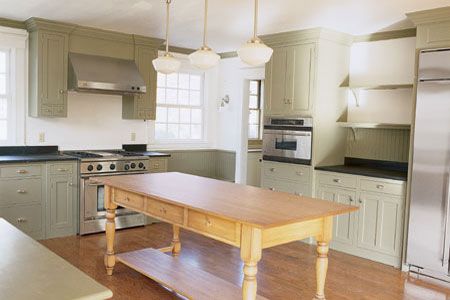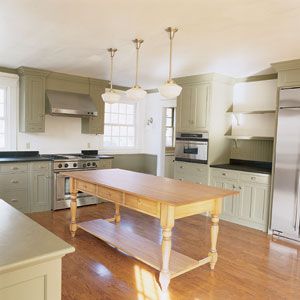
From the first day it was clear: The kitchen at the This Old House TV project in Winchester, Massachusetts, was old, dark, and outdated. When homeowners Kim Whittemore and Bruce Leasure bought the house, they got a 1960s cliche, down to the brown cabinets, gold-marbled Formica, and floral-stripe wallpaper. The room needed an overhaul, so the couple started planning almost as soon as they signed the check at the closing.
Over the next six months, the Winchester kitchen was demolished, reimagined, measured, ordered, and installed. Carpenters, electricians, plumbers, flooring installers, and countertop fabricators created a period-appropriate kitchen for the 1922 Colonial Revival house. Now it’s the couple’s ideal kitchen — maybe their favorite room. “We love every detail in here,”says Bruce. “And let me tell you, there were a lot to keep track of.”
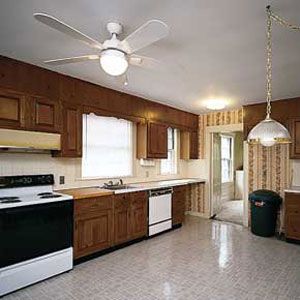
Making the Plan
Homeowners Kim and Bruce started their kitchen overhaul where all This Old House homeowners start: with TOH general contractor Tom Silva and an architect — in this case David Stirling. Stirling, who designed the whole house renovation, came up with a plan to expand the 13-by-18-foot kitchen to 400 square feet. Then the homeowners asked kitchen designer Jeff Peavey, co-owner of The Kennebec Company, to work out the custom details.
When Peavey first met with the couple, four months before the finish date — a rush job, for sure — he asked them what they liked and didn’t like about other kitchens. The couple brought magazine clippings and talked about layout, finishes, hardware, lighting, counters, appliance placement, and functionality. “Even if a homeowner only has some of his or her preferences in mind,” says Peavey, “that can help direct the conversation and the choices presented to them from there on.” The couple wanted furniture-grade cabinets and pro appliances in a place comfortable enough for both entertaining and intimate meals. “We?d never use a formal dining room,” says Kim. “We usually end up around the kitchen table.” Peavey looked for inspiration to kitchens installed at Colonial Williamsburg during its 1920s restoration, which had painted cabinets and large worktables.
As they talked, Peavey sketched out a rough floor plan on graph paper. It was this sketch that he then took back to the designers at his shop in Bath, Maine. Over the next four weeks, a crew of six designers worked on separate areas of the room, then combined their individual ideas to plan the full space. Their meetings produced a set of detailed pencil sketches, complete with elevations of each wall.
At the same time that they worked out the cabinet design, the designers and homeowners also chose appliances, countertops, lighting, and flooring, all decisions that have to be made in concert to keep the layout in order. It wasn?t until these details were sorted out that Peavey could make final blueprints.
Kennebec took exact measurements of the framed-in room and produced mechanical drawings. After a few minor adjustments, Peavey gave the final plans to the shop two weeks later, and cabinetmakers began to build Kim and Bruce’s kitchen.
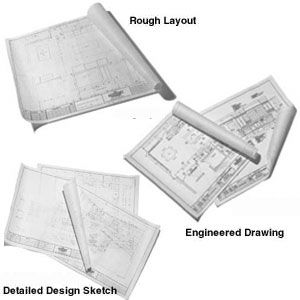
Making It Happen
While the kitchen plans were being mapped on paper, the Silva Brothers team ripped down the walls designated for demolition. Then they beefed up a back wall support beam with steel and engineered lumber to support the two floors and roof above. “The upper levels were held up with just one 4×8,” says Tom. “How’s that for getting it wrong in 1922?” Only after he was confident the back wall was strong enough did Tom start framing.
With the layout established, the subcontractors readied the room for wallboard. Master electrician Allen Gallant roughed in wiring for the lighting and appliances, while master plumber Ronald Coldwell installed pipes for the sinks, disposer, dishwasher, and refrigerator.
When the cabinets arrived, Stephen Long and Tim Donovan, finish carpenters with the patience of monks, took over. Slowly, carefully, they measured, scribed, sanded, planed, and leveled. In a week, they had installed the lower cabinets. That?s when the soapstone countertops came. Luckily, they could be cut to fit on-site — some stone countertops require the cabinet installation to pause for a week or more while fabricators make a template for a shop to cut them.
Soon the room was abuzz with the sounds of the trades: carpenters, plumbers, electricians, floorers, all working in harmony. After months of preparation, cabinets went up and beadboard was wrapped around the walls of the room. Lighting fixtures were installed over the table/island, and the tiger-maple secretary found a home between two doors.
Conceived and drawn on paper, the kitchen now was complete — a room that evoked another era, displaying the craft and the care of many hands.
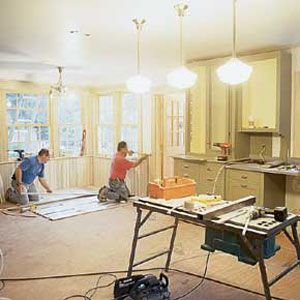
Where to Find It
Architect:
David Stirling
AIA
Stirling/Brown Architects
Winchester, MA
781-721-1310
Custom cabinetry:
The Kennebec Company
Bath, ME
207-443-2131
Cabinetmaker:
Tim Donovan
Wiscasset, ME
207-882-1214
General contracting:
Stephen Long
Stephen P. Long Homebuilder
Mendon, VT
802-775-6202
